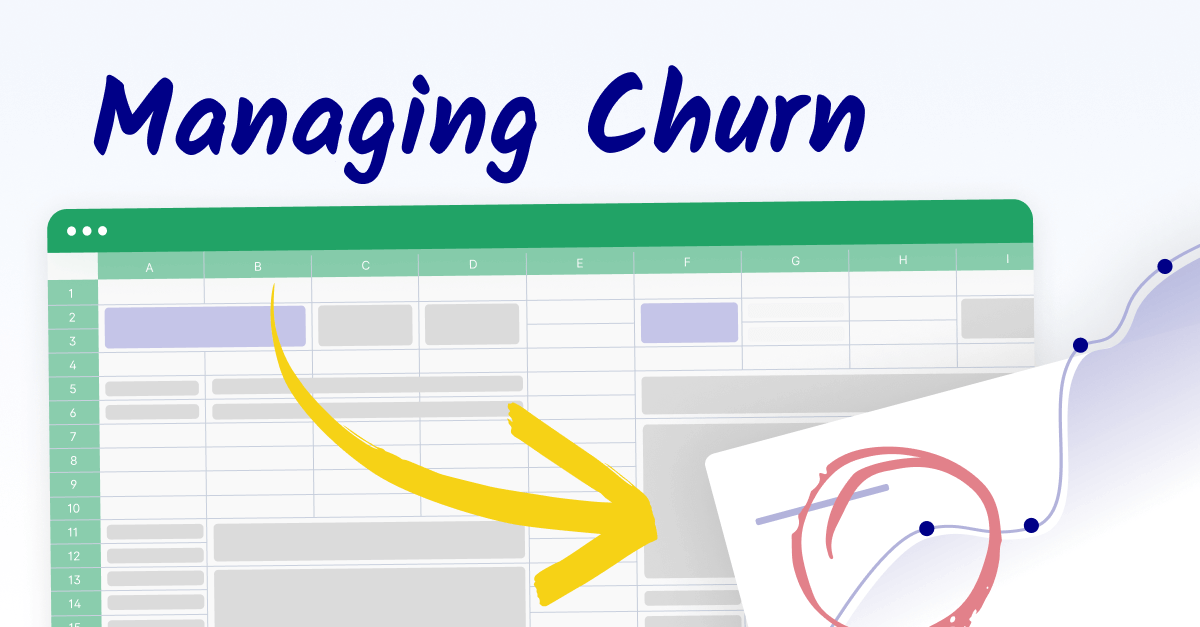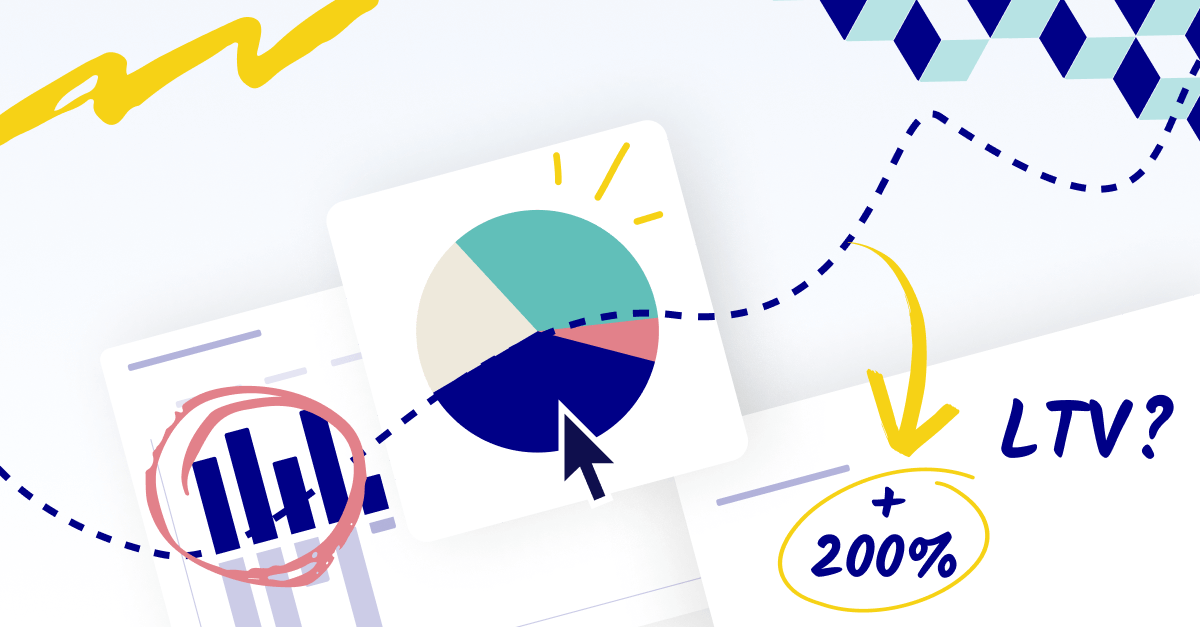Key takeaways
- Revenue churn is the revenue loss from losing a customer.
- Revenue churn rate is the percentage of revenue you've lost to churn or downgrades.
- Net revenue churn is the percentage of revenue lost to churn or downgrades combined with the revenue gained from expansions.
- A negative net revenue churn rate signals growth.
- Creating a better customer experience is an effective way to minimize revenue churn.
What is revenue churn?
Churn happens whenever a customer stops doing business when a company.
Revenue churn is the revenue loss from that event.
Revenue churn is also known as MRR (monthly recurring revenue) churn. The revenue churn rate is the percentage of revenue lost to cancellations and downgrades.
Here's an example:
- You have $100,000 in MRR.
- You lose $10,000 from customers leaving or downgrading their plan.
This means you lost $10,000 in churn, so you have a 10% revenue churn rate.
(This is called a gross revenue churn rate, by the way.)
How revenue churn differs from customer churn
Both are churn. Revenue churn measures revenue lost; customer churn measures customer count lost.
In other words, customer churn answers the question: What percentage of customers did we lose in the past month?
And revenue churn answers the question: What percentage of revenue did we lose last month?
That’s a meaningful difference, but it’s also a subtle one. Different customers can bring in different amounts of revenue, after all.
When discussing ways to minimize revenue churn, we must discuss customers.
Here’s an example:
Example: revenue churn vs. customer churn
Assume the following pricing for a SaaS company:
| Plan |
Monthly Price |
# of Customers |
MRR |
| Essential |
$600 |
50 |
$30,000 |
| Premium |
$1,000 |
30 |
$30,000 |
| Enterprise |
$2,000 |
20 |
$40,000 |
Now, say this company has a 5% customer churn rate.
That’s not useful information, is it?
Because we need to know where the churn is coming from.
They could have lost 5 enterprise customers (10% of their MRR) or 5 essential plan customers (3% of their MRR).
Massive difference, right?
But if we said they lost 5% of the MRR, you wouldn’t know how many customers they lost, nor in which pricing tiers.
That’s why it’s important to use both.

Why is revenue churn important for a SaaS business?
Revenue churn is a stability metric. A business with a low revenue churn rate does a better job of retaining incoming revenue (and, by proxy, customers) than a business with a higher revenue churn rate.
This signals a few important things to investors and stakeholders:
- Product-market fit is good: If customers stay, the business has solved an important problem.
- The business is resilient to changes in the market: Barring some situations where a business is the only player in a market, customer loyalty signals better stability and easier forecasting.
- Customer and brand loyalty is likely excellent: Customers who stay with you are more likely to sign on when you introduce the next tier or the next product.
This all signals that the business is stable.
What does revenue churn mean for a SaaS business?
An increase in revenue churn can signal a few different things:
- Poor customer fit: Churn is natural (and expected) if a customer isn't the right fit for the product.
- Changing needs not met: Customer needs change—problems get more complex or solved entirely. In B2C, personal projects arise and get dropped as priorities change.
- Poor customer service Experience: 85% of customers cite a bad customer service experience as a primary reason for churning.
As with any metric, consulting with Operations, Product, and Customer Success is important to get the full picture of what's happening in the business.
What is considered an acceptable revenue churn rate?
According to Baremetrics, SaaS companies that target SMBs should shoot for under a 3-5% monthly churn rate. Established SaaS companies should shoot for a 5-7% annual churn rate.
CoBloom found in a SaaS company analysis that a 5% churn rate shouldn't be seen as a clear-cut barrier to growth.
How does revenue churn affect the LTV/CAC ratio?
Revenue churn is often the source of lagging growth metrics like the LTV/CAC ratio.
In this case, because customers are churning, LTV goes down. So it's difficult to meet that ideal 3:1 ratio.
How to calculate revenue churn
Revenue churn is simple to calculate.
Revenue Churn Rate = (Contractions + Exits) / MRR
In other words, the revenue churn rate is the ratio of lost revenue to monthly recurring revenue.
Not detailed enough?
Fortunately, you can dig a little deeper by calculating revenue churn in a few different ways.
Negative net revenue churn
A net revenue churn rate accounts for expansions as well as contractions.
It’s a slightly different view of the business’s churn rate because it acknowledges growth from existing customers and decline from losing customers.
(An expansion is when an existing customer moves up a pricing tier or purchases an additional product.)
Here’s the formula:
Net Revenue Churn Rate = (Contractions + Exits - Expansions) / MRR
As you can see, this is extremely similar to our previous formula.
The only difference is that we subtract out expansions.
In practice, here’s what it looks like:
Take our previous example, but say we also gained $20,000 in expansions.
Then our net revenue churn rate is as follows:
Net revenue churn rate = $5,000 + $5,000 - $20,000 / $100,000
= - $10,000 / $100,000
= -10%
So even though we made more money this month than we did last month, our net revenue churn rate is negative.
That’s because we made more from expansions than we lost to churn.
In other words:
Negative net revenue churn is good for business!
Revenue churn on a cohort basis
Until now, we’ve been calculating revenue churn with our entire customer base.
But you can (and should) calculate revenue churn by cohort.
This helps you better understand how specific segments of your customer base are performing.
...what’s a cohort?
A cohort is a subdivision of a customer base that shares a common characteristic.
For example, they could all live in New York City, belong to Mid-Market companies, or work in the pet insurance sector.
This means:
It’s possible to segment by location, size, industry, and other factors (country, market share, language, etc.).
If you find a specific cohort that does well, that’s an opportunity for easy growth.
If you don’t do well with a different cohort, then it’s worth discovering why.

How to improve revenue churn
Like any churn, revenue churn results from a few key issues:
- Poor customer service experiences: People sign up for a product because they have a goal and a problem in the way of realizing that goal. Customer service that adds to their frustration is a recipe for disaster.
- Poor customer fit: If people aren’t a good fit, it only makes sense that they’ll churn.
- Lack of value: If people don’t think they’re getting enough value for what they’re paying, they’ll churn. This could mean their problem isn’t solved, they think they’re paying too much, or a competitor offers a more attractive package.
The fix, then, is to improve most of these metrics.
- Create a customer success plan to reduce friction and frustration around the customer experience. That might mean improving the product UI, adding more integrations, and investing in your customer success team.
- Clarify your messaging: Your messaging is the first thing potential customers see; you want it to resonate with the right customers and repel the ones who aren’t a good fit.
- Add more value to the product: Revenue churn can happen because customers outgrow your product or a competitor enters the market. The way to beat this is to add more value to your offerings to better serve your customers.
Ask for feedback
Don’t let customers churn without telling you why they’re leaving you.
When a customer downgrades a package or cancels their subscription, you should ask them why.
This feedback will help you better tailor your revenue churn initiatives.
Active churn prevention
There’s an opportunity to make customers second-guess their decision to downgrade or churn.
When customers tell you they want to churn, give them a counteroffer.
You can do this right before they confirm their decision.
Here are some tactics:
- Remind them what your product can do: If customers churn because they don’t realize your product has some functionality to solve their problems, remind them.
- Ask them to schedule time with the customer success team: A good percentage of customers who churn are frustrated. Offering time with customer success to hear about their problems and find a solution shows that you’re invested in helping them.
- Offer a down-sell: This doesn't eliminate churn entirely but softens it. Instead of canceling entirely, ask them if they want to lower to a cheaper (or free) plan.
That said, all of this may seem like too little, too late, especially if your customer success team doesn’t have a good reputation or your brand doesn’t have a good rapport with that customer.
What doesn't revenue churn tell us?
Revenue churn isn't a catch-all metric.
You need to supplement it with other metrics in order to get the full story.
Revenue churn doesn't tell us about changes in customer count
Since revenue churn is purely financial, it doesn't go into the details of customers.
This is particularly damaging to businesses that ignore that they're losing thousands of customers (who could have grown into higher pricing tiers) because their revenue churn is low or acceptable.
In other words, because revenue churn only looks at money, it obscures the story of customer count.
Revenue churn doesn't tell us about the strength of the customer relationship
A low revenue churn rate correlates with stronger customer loyalty, but there are plenty of other factors that could be at play, like:
- Lack of (good) competition
- Environmental factors that make the problem you solve more pressing
- High cost of switching
Since the strength of your customer relationships is important to your revenue retention going forward, it's essential that you build a strong rapport with your customers.
Revenue churn doesn't explain seasonality
While revenue churn can definitely help you identify seasonality in groups of customers who use your product, it doesn't tell you why it happens.
It could be that those variations are perfectly normal and related to the calendar year.
But either way, you need to combine revenue churn with reactivation retention, among other metrics, in order to accurately understand how seasonality affects your bottom line.
Conclusion: all about revenue churn
Now you know what revenue churn is, how to calculate it, and how to improve it.
Which of these strategies will you try first?
Maybe you're going to create a customer success plan.
Or you're going to try some active churn prevention.
Share this on LinkedIn and tag us to keep the conversation going.



.png)









.png)
.png)




.png)
.png)